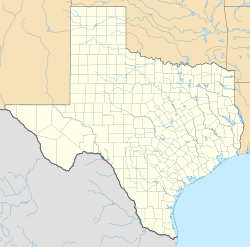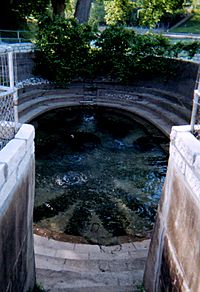Barton Springs facts for kids
Quick facts for kids Barton Springs |
|
|---|---|

Main Barton Spring, inside Barton Springs Pool
|
|
| Spring source | Edwards Aquifer |
| Elevation | 435 ft (133 m) above sea level |
| Type | Karst States |
| Provides water for | Barton Creek and Colorado River |
| Magnitude | 2 |
| Discharge | 66 ft³/s (1869 L/s) |
|
Barton Springs Archeological and Historical District
|
|
| Location | Zilker Park, Austin, Texas |
|---|---|
| Area | 138.5 acres (56.0 ha) |
| Built | 1891 |
| Architectural style | Tudor Revival, Bungalow/Craftsman, Queen Anne |
| MPS | HBarton Springs MPS |
| NRHP reference No. | 85003213 |
| Added to NRHP | November 27, 1985 |
Barton Springs is a group of four natural water springs. They are found at Barton Creek in Zilker Park in Austin, Texas. These springs are fed by water flowing through the Edwards Aquifer.
The biggest spring is called Main Barton Spring, also known as Parthenia. It provides water for Barton Springs Pool. This pool is a very popular place for swimming in Austin. The other three springs are smaller and are located nearby. Some of them have special structures built around them.
Barton Springs is also the only known home for the Barton Springs salamander. This special type of salamander is an endangered species. In 1985, the area around the springs was named the Barton Creek National Archeological and Historic District.
Contents
How Barton Springs Works
Barton Springs is the main place where water leaves the Barton Springs part of the Edwards Aquifer. An aquifer is like a huge underground sponge made of rock that holds water. This aquifer is a special type called a karst aquifer. It is made of limestone rock that is about 100 million years old.
Over time, cracks, openings, and even caves have formed in this limestone. These spaces got bigger because of natural forces like faults (breaks in the rock) and water slowly dissolving the limestone. This creates a network of large open spaces underground. Rainwater then fills these spaces.
All the water that comes out of Barton Springs starts as rainfall. Some rain falls directly onto the land where the limestone rock is exposed. This area is called the recharge zone. Other rain flows into creeks that cross this zone and then sinks into the limestone. Once the water is underground, it flows to the lowest pressure point, which is Barton Springs.
Main Barton Spring
Main Barton Spring, or Parthenia, is the most famous spring. It is also the hardest to see because it is completely underwater in Barton Springs Pool. You can find it near the diving board. Its flow is not always visible on the surface of the pool.
This main spring releases a lot of water. On average, it discharges about 31 million US gallons (117,000 cubic meters) of water every day. During a big drought in the 1950s, the flow dropped to 9 million US gallons (34,000 cubic meters) per day. But during floods in 1991, it reached 85 million US gallons (322,000 cubic meters) per day! To give you an idea, a typical home swimming pool holds about 50,000 US gallons (189 cubic meters). The city of Austin, with about a million people, uses around 120 million US gallons (454,000 cubic meters) of water daily.
Other Springs at Barton
Besides Main Barton Spring, there are three other springs: Eliza, Old Mill, and Upper Barton Spring. These are much smaller. They discharge about 3 million US gallons (11,000 cubic meters) of water per day on average. Sometimes, these smaller springs can even dry up completely.
Eliza Spring, also known as Concession Spring, is near the north entrance of Barton Springs Pool. It is about 300 feet (100 meters) east, towards the children's playscape. In the early 1900s, a swimming area was built around it. However, this area is now closed to the public. This is because of safety reasons and because Eliza Spring is an important home for the endangered Barton Springs salamander.
Old Mill Spring, also called Sunken Gardens Spring or Zenobia Spring, is on the south side of Barton Springs Pool. Like Eliza Spring, the structure built around it in the early 1900s is now closed. This is also due to safety concerns and to protect endangered species. Scientists have found that the water in Old Mill Spring has a slightly different chemical makeup than the water in Main Barton Spring and Eliza Spring. This is true even though it is less than half a mile (800 meters) away.
Upper Barton Spring is located in the bed of Barton Creek. It is about half a mile (800 meters) upstream, or west, of Barton Springs Pool. This spring is often dry. During floods, it gets completely covered by Barton Creek. The water at Upper Barton Spring also has a noticeably different chemical makeup compared to the other springs.
The whole area around Barton Springs has many faults (cracks in the Earth's crust). There are also other smaller springs. For example, about one mile (2 kilometers) upstream from Upper Barton Spring, there is a spring that sometimes fills a popular natural swimming hole. Several other small springs flow directly into the Barton Creek bypass tunnel, which runs next to Barton Springs Pool.
Animals at Barton Springs
Two types of salamanders live only at Barton Springs. They are the Barton Springs salamander and the Austin blind salamander. These unique creatures depend on the springs for their survival.




